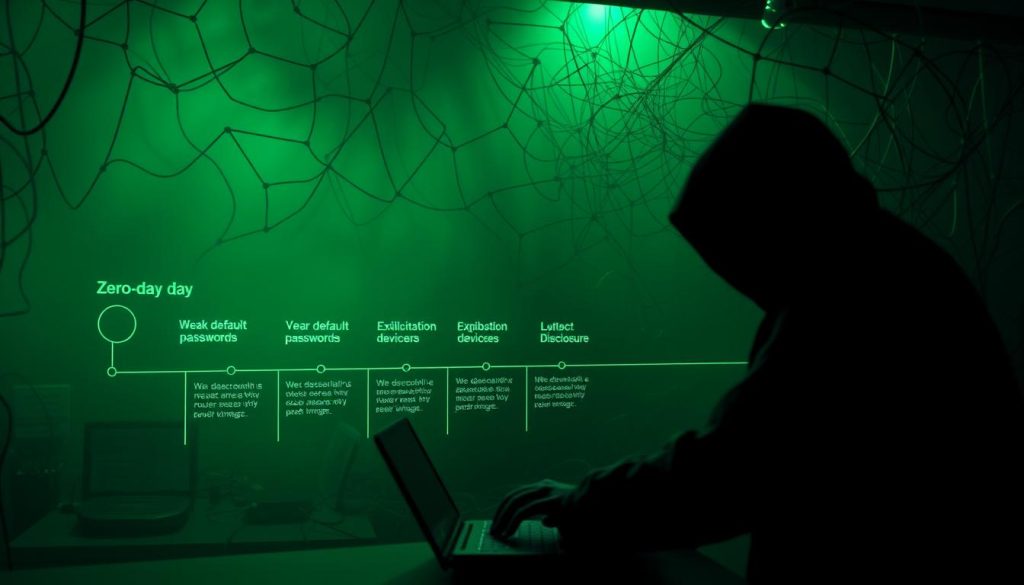Remote work is now common, making home user security more important than ever. Employees working from home face a higher risk of cyber threats. This is because of zero-day vulnerabilities, which are unknown software flaws that hackers exploit before a fix is found.
It’s crucial to know about these vulnerabilities and protect your home network and devices. Keep your software updated, use strong antivirus, and be careful with emails and downloads.
Key Takeaways
- Understand the risks associated with zero-day vulnerabilities.
- Keep your software and operating systems updated.
- Use robust antivirus programs.
- Be cautious with emails and downloads from unknown sources.
- Implement strong security practices at home.
Understanding Zero-Day Vulnerabilities
Zero-day vulnerabilities are a big threat to your online safety. It’s important to know what they are and why they matter. These issues affect not just big companies but also people at home.
Definition and Importance
A zero-day vulnerability is a flaw in software or hardware that no one knows about yet. It’s called “zero-day” because the maker has no time to fix it before hackers find it. Knowing about zero-day vulnerabilities is key because hackers can use them to get into your devices or data.
Zero-day vulnerabilities are a big deal for your digital safety. For example, default passwords and router security issues are common ways hackers get in. Studies show many home and office routers have weaknesses that hackers could use. This shows why you need to be careful and take steps to protect your network.
How They Differ from Other Vulnerabilities
Zero-day vulnerabilities are different because they are unknown and can’t be fixed right away. Unlike known vulnerabilities, which might have patches, zero-day ones leave you open until a fix is found. This makes them very dangerous because hackers can use them without being caught by usual security.
Also, using zero-day vulnerabilities often needs smart tricks, like phishing emails. These are the top way hackers attack. Knowing this helps you understand the risks and how to protect yourself.
Common Sources of Zero-Day Vulnerabilities
Zero-day vulnerabilities come from many places, like operating systems and third-party software. Knowing where they come from helps strengthen your cybersecurity.
Operating Systems
Operating systems (OS) are often targeted by zero-day attacks. These attacks can let hackers control your system, steal your data, or install malware. It’s key to keep your OS updated to avoid these risks.
Browsers and Web Applications
Web browsers and apps are also common targets. Using outdated browsers or plugins can put you at risk. Make sure your browser and its parts are current.
Third-Party Software
Third-party software, like apps and plugins, can have zero-day flaws. It’s important to update these regularly to stay safe.
Many home routers use default passwords, making them vulnerable to hackers. Changing your router’s password to a secure router password is a simple way to boost your network’s security.
| Source | Vulnerability Risk | Mitigation Strategy |
|---|---|---|
| Operating Systems | High | Regular Updates |
| Browsers and Web Applications | Medium to High | Update Browser and Plugins |
| Third-Party Software | Medium | Regularly Update Applications |
| Home Routers | High | Change Default Admin Password |
How Zero-Day Vulnerabilities Are Discovered
Zero-day vulnerabilities are found by security researchers and cybercriminals. This shows how complex cybersecurity is. Both good and bad actors have big roles.
Role of Security Researchers
Security researchers are key in finding zero-day vulnerabilities. They use fuzz testing and code review to spot weaknesses in software. For example, an Israeli researcher, Ido Hoorvitch, cracked over two-thirds of WiFi passwords in Tel Aviv. This shows why strong security is vital.
These experts work with software makers to fix these issues. Their work helps stop cybercriminals from using these weaknesses.
Impact of Cybercriminals
Cybercriminals also find zero-day vulnerabilities, but they do it for bad reasons. They use these to make money or cause trouble. Their actions can lead to big problems, like data theft and financial losses.
To fight these risks, protecting your router is crucial. Here are some ways to do it:
- Change default passwords to strong, unique ones.
- Update your router’s firmware often to fix known issues.
- Use WPA3 encryption to make your WiFi safer.
- Turn off WPS (Wi-Fi Protected Setup) to block unwanted access.
Knowing how zero-day vulnerabilities are found helps you protect your systems. By staying informed and proactive, you can keep your cybersecurity strong.
The Lifecycle of a Zero-Day Vulnerability
Understanding the zero-day vulnerability lifecycle is key to better home security. It has several important stages. Knowing these can help protect your digital world.
Discovery
The first step is when a zero-day vulnerability is found. This can happen through security research or by hackers. Now, makers must give unique passwords and tell how long devices will get updates. This helps users stay ahead.
Exploitation
After it’s found, hackers try to use the vulnerability. They might steal data or crash systems. It’s vital to be alert and change passwords, like router ones, to block hackers.
Patching
The last step is fixing the problem with patches. Makers work on these fixes after a vulnerability is found. Keeping your software updated is crucial to get these fixes.
Here’s a table showing the lifecycle and what you should do:
| Stage | Description | User Action |
|---|---|---|
| Discovery | Vulnerability identified by researchers or cybercriminals. | Stay informed through security blogs and alerts. |
| Exploitation | Cybercriminals use the vulnerability to gain unauthorized access. | Change default passwords, use antivirus software. |
| Patching | Manufacturers release patches to fix the vulnerability. | Regularly update your software and systems. |

Knowing the zero-day lifecycle and acting early can lower your risk of cyber attacks. Remember, keeping your digital world safe is a constant effort that needs your attention and quick action.
Why Home Users Should Be Concerned
Zero-day vulnerabilities are a big threat to home users. They can harm personal data and financial security. As hackers get better, the danger to home users grows. It’s key to know how these vulnerabilities affect us.
Personal Data Protection
Home users worry a lot about keeping their personal data safe. Zero-day vulnerabilities let hackers get into our private info. This can include things like passwords, bank details, and personal documents.
This can lead to identity theft, financial fraud, and other big problems. To stay safe, make sure your devices and software are current. Also, think about using antivirus software and firewalls.
Financial Implications
The financial risks of zero-day vulnerabilities are huge. Hackers can steal money, do fake transactions, or even demand money for your data back. Plus, fixing a cyberattack can cost a lot. This includes fixing or replacing devices and legal fees.
Home users need to be careful with their money. Check your accounts often and be careful with emails and links from strangers.
Recognizing Signs of a Potential Zero-Day Attack
Knowing the signs of a zero-day attack helps you act fast and right. These attacks use new, unknown weaknesses. They are hard to stop because they are new.
Unusual System Behavior
Unusual system behavior is a big warning sign. It might show as changes to your system settings or strange programs running. If your computer acts weird or shows odd messages, it could be a problem.
Watch out for slow network speeds or unknown devices in your router logs. These signs can mean your network is under attack.
Frequent Crashing or Freezing
Frequent crashing or freezing is another warning. If your computer or apps crash a lot, it might be under attack. This could be a sign of a bad exploit trying to get in.
Also, don’t ignore default password risks. Many devices and software have easy-to-find default passwords. Not changing these can leave your system open to attacks.
To stay safe, keep an eye on your systems. Check system logs often and be careful with network connections. This helps spot threats early.
Best Practices for Home Users
To keep your digital world safe, it’s key to know and follow home user best practices. Your digital security is as strong as your weakest link. So, keeping up with maintenance and staying alert is vital.
Regular Software Updates
Keeping your software current is a simple yet powerful way to shield your devices. This includes your operating system, browser, and apps you use often. Updates patch security holes found since the software was first released.
Why Regular Updates Matter:
- They fix security holes that malware or hackers could use.
- They make your software run better and more smoothly.
- They bring you the latest features and security boosts.
Use of Antivirus Programs
Antivirus software is a must-have for your digital safety. It guards against malware like viruses, Trojans, and ransomware. Choose an antivirus that offers real-time protection, updates, and thorough scans.
Key Features of Effective Antivirus Software:
| Feature | Description | Benefit |
|---|---|---|
| Real-time Protection | Always watches your device for threats. | Quickly spots and acts on threats. |
| Regular Updates | Keeps the software up with new threats. | Protects against new malware. |
| Comprehensive Scanning | Checks your device and files deeply for malware. | Finds and removes hidden threats. |
Also, don’t forget to keep your router password safe. Your router is a key to your network, and a strong, unique password keeps it locked. Update your router’s firmware often for security and performance boosts.
By sticking to these practices, you can greatly improve your home network’s security. Regular updates, antivirus use, and a secure router password are key to a strong defense.
Using Firewalls to Protect Against Zero-Day Threats
To keep your home network safe from cyber threats, especially zero-day attacks, using firewalls is key. Firewalls block unwanted internet access and control network traffic. They do this by following security rules you set.
Importance of Firewalls
Firewalls are vital in fighting zero-day threats. They stop unauthorized access to your network. By setting up your firewall right, you lower the chance of your network getting hacked through zero-day attacks.
Key Benefits of Firewalls:
- Network Traffic Control: Firewalls let you decide what traffic can enter and leave your network.
- Blocking Malicious Activity: They spot and block harmful activity, including zero-day exploits.
- Enhanced Security Layer: Firewalls add a crucial security layer to your network, working with other security tools like antivirus software.
Configuring Your Firewall Properly
Setting up your firewall correctly is key to protecting your network. Here’s how to do it:
- Enable Your Firewall: Make sure your firewall is on for all devices on your network.
- Configure Rules: Create rules for incoming and outgoing traffic. For example, block traffic from certain IP addresses or limit access to specific ports.
- Regularly Update: Update your firewall software regularly to stay ahead of new threats.
| Firewall Configuration Tips | Description | Benefit |
|---|---|---|
| Enable Firewall on All Devices | Ensure the firewall is turned on for all devices on your network. | Comprehensive Protection |
| Customize Rules | Set specific rules for incoming and outgoing traffic. | Granular Control |
| Regular Updates | Keep your firewall software updated. | Protection Against Latest Threats |
By understanding firewalls’ importance and setting them up right, you boost your network’s security against zero-day threats.

The Role of Intrusion Detection Systems
Intrusion detection systems are key in spotting threats to your home network. They watch network traffic for signs of unauthorized access or malicious activity. Knowing how they work helps protect your personal data and boosts your cybersecurity.
Understanding Intrusion Detection Systems
Intrusion detection systems (IDS) are software or hardware that alert you to network threats. They analyze network traffic and system logs to find malicious activity. This early warning lets you act fast to stop or lessen a cyber attack.
Benefits for Home Users
For home users, IDS systems have many benefits. They protect your personal data by spotting threats early. They also keep your home network safe by detecting and stopping malicious activity. Using an IDS system greatly improves your cybersecurity.
It’s also important to follow other cybersecurity best practices. For example, changing your router’s default password is a simple yet effective step. Default passwords are easy for cybercriminals to find. So, using strong, unique passwords can greatly improve your security.
By using IDS systems and other cybersecurity measures, you can build a strong defense against cyber threats. Remember, cybersecurity is an ongoing process. It needs constant vigilance and updates to stay ahead of new threats.
Staying Informed About Vulnerabilities
In the world of cybersecurity, staying informed is key to fighting zero-day threats. Keeping up with new security steps helps protect your personal and digital world.

Following Security Blogs
Following security blogs is a smart way to stay ahead. These blogs share news on new threats, fixes, and how to keep your devices safe. Look for blogs from top cybersecurity firms and independent experts.
- Subscribe to blogs that share the latest on cybersecurity threats.
- Find blogs that give practical tips for securing your online space.
- Join in by reading comments and taking part in discussions.
Using Alerts and Feeds
Alerts and feeds are also vital. Many groups send out emails or RSS feeds about new threats and updates. By joining these, you get quick alerts to stay safe.
- Sign up for alerts from trusted cybersecurity sources.
- Adjust your feed settings to get updates that matter to you.
- Quickly act on the info you get to protect your systems.
Don’t forget about router security and default password risks. Changing your router’s default password is a simple way to boost your network’s safety. Keeping your router’s software up to date and using strong passwords also helps a lot.
By following security blogs, using alerts and feeds, and keeping your router secure, you can greatly improve your defense against threats. This way, you can better protect your digital life.
How to Respond to a Suspected Zero-Day Attack
A suspected zero-day attack needs quick and smart action to protect your systems and data. If you think your computer or network is under attack, act fast to lessen the damage.
Immediate Steps to Take
If you think you’re under attack, there are key steps to take right away. First, disconnect from the internet quickly to stop more harm. This simple step can help keep the attack from getting worse.
Next, run a full system scan with your antivirus software. This will help find and remove any malware. Make sure your antivirus is up to date to catch the malware better.
Also, change all passwords and think about using two-factor authentication. This adds more security and stops unauthorized access to your accounts.
| Immediate Action | Purpose |
|---|---|
| Disconnect from the internet | Prevent further damage |
| Run a full system scan | Detect and remove malware |
| Change all passwords | Prevent unauthorized access |
Reaching Out for Professional Help
If you’re not sure what to do or if the attack is too big for you, get professional help. Cybersecurity experts can guide you and help you fix the damage. They can also protect your systems from future threats.
Also, talk to your Internet Service Provider (ISP) for tips on protecting your router from hacking. They can share ways to keep your home network safe and prevent future attacks.
By acting fast and getting help when needed, you can handle a suspected zero-day attack well. This way, you can reduce its impact on your digital life.
Collaborating with Your ISP for Enhanced Security
Working with your ISP can make your home network much safer. Your Internet Service Provider is key to your online safety. Learning how to team up with them can add extra protection against cyber threats.
Importance of Communication
Talking well with your ISP is the first step to better security. By sharing your security worries and needs, you can spot and fix weak spots together. Keeping up with security updates is also crucial for a safe connection.
Maintaining a secure router password is vital. A strong password keeps your network safe from hackers. Your ISP can help you choose and manage a strong password.
Potential Services Offered
Many ISPs have extra security tools to keep you safe from cyber threats. These tools include:
- Malware detection and removal tools
- Firewall configuration and management
- Parental controls to restrict access to certain content
- Alerts and notifications about potential security threats
Some ISPs also offer security software or work with cybersecurity firms. It’s important to ask about these services and how they fit into your security plan.
| Security Service | Description | Benefit |
|---|---|---|
| Malware Detection | Tools that identify and remove malware from your devices | Protects against viruses and other malicious software |
| Firewall Management | Configuration and management of firewall settings | Blocks unauthorized access to your network |
| Parental Controls | Features that restrict access to certain content | Helps in controlling what content is accessible to children |
By using these services and talking often with your ISP, you can greatly improve your network’s security. Remember, keeping your network safe is a team effort. Your ISP is a big help in this fight.

The Future of Zero-Day Vulnerabilities
Technology keeps getting better, and so does the world of zero-day vulnerabilities. It’s important to keep up with the latest in cybersecurity to protect your online stuff.
Cybersecurity Trends
There are big changes coming in cybersecurity. Artificial intelligence (AI) and machine learning (ML) are becoming more common. They help keep things safe, but they also create new risks.
Be careful with these new technologies. For example, AI can be tricked by smart hackers, leading to new zero-day attacks.
| Cybersecurity Trend | Impact on Zero-Day Vulnerabilities | Mitigation Strategy |
|---|---|---|
| Increased use of AI and ML | New vulnerabilities and exploit techniques | Implement AI/ML security measures and monitor for suspicious activity |
| Growing IoT ecosystem | Expanded attack surface with more connected devices | Secure IoT devices with strong passwords and regular updates |
| Cloud computing adoption | Potential for cloud-specific zero-day vulnerabilities | Use cloud security best practices and monitor cloud service configurations |
Evolving Threat Landscapes
Threats are always changing, with hackers finding new ways to use zero-day bugs. You must stay alert and update your security plans.
Phishing attacks are getting smarter, aiming to use zero-day bugs. Be careful with emails or messages that seem off, especially those with links or attachments.
To keep your home network safe, make sure your router is secure. Update its software, use a firewall, and change the admin password. Also, turn on WPA3 encryption.
By keeping up with zero-day vulnerabilities and cybersecurity trends, you can better protect yourself from new threats.
Educational Resources for Home Users
Home users can boost their cybersecurity by using online educational resources. These tools teach users how to secure their home networks. They also show how to change router passwords and fight off cyber threats.
Online Courses and Webinars
Online courses and webinars are great for those wanting to learn more about cybersecurity. Many groups offer these tools. They cover everything from basic security to advanced threat strategies.
Community Forums and Support Groups
Community forums and support groups are places for users to talk about cybersecurity. They share knowledge and get advice from others. These groups are key for solving problems and staying updated on threats.
To improve cybersecurity, home users should follow these steps:
- Regularly update your operating system and software.
- Use strong, unique passwords for all accounts.
- Enable firewall protection on your network.
| Practice | Description | Benefit |
|---|---|---|
| Regular Updates | Keep your OS and software up-to-date. | Protects against known vulnerabilities. |
| Strong Passwords | Use complex, unique passwords. | Prevents unauthorized access. |
| Firewall Enablement | Activate firewall on your network. | Blocks malicious incoming and outgoing connections. |
Conclusion: Prioritize Your Cybersecurity
As we wrap up our discussion on zero-day vulnerabilities, it’s clear that prioritizing cybersecurity is crucial for home users. You must stay informed and vigilant to protect your personal data and devices from potential threats.
Effective Measures
To enhance your cybersecurity, focus on taking action by securing your router and network. Ensure you change weak default router passwords and keep your software up-to-date. Regularly updating your operating system, browser, and other software is vital in preventing exploitation of known vulnerabilities.
Staying Ahead
Staying vigilant involves continuously monitoring your system’s behavior and being aware of the latest cybersecurity trends. By doing so, you can quickly identify and respond to potential threats. Prioritizing cybersecurity is an ongoing process that requires your attention and proactive measures to stay ahead of emerging threats.
By taking these steps, you can significantly improve your cybersecurity posture and protect your digital life from the ever-evolving landscape of cyber threats.

